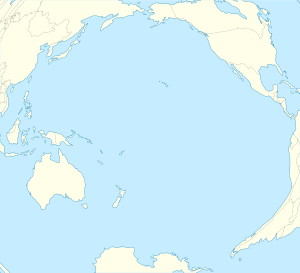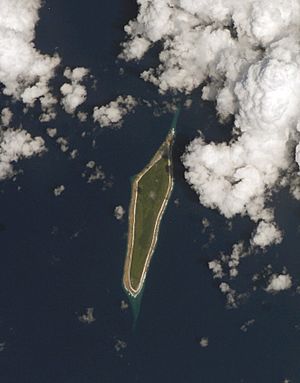Flint Island facts for kids
Flint Island is a small coral island in the middle of the Pacific Ocean. No one lives on it. It's part of the Southern Line Islands and is controlled by the country of Kiribati. In 2014, the government of Kiribati created a special zone around Flint Island and other nearby islands. This zone stretches out about twelve-nautical-mile (22-kilometre; 14-mile) from the shore, meaning boats need special permission to enter.
Where is Flint Island?
Flint Island is located about 740 kilometres (400 nautical miles; 460 miles) northwest of Tahiti. It's also about 190 kilometres (100 nautical miles; 120 miles) south-southeast of Vostok Island and 220 kilometres (120 nautical miles; 140 miles) southwest of Caroline Island.
The island is shaped like a long, narrow strip of land. It's about 2.5 miles (4.0 kilometres) long and 0.5 miles (0.8 kilometres) wide at its widest point. The total land area is about 1 square mile (2.6 square kilometres).
Flint Island is quite low, rising only about 25 feet (7.6 metres) above the sea. A narrow reef surrounds the island, making it hard for boats to land safely.
Long ago, the island was covered in thick, wild forests. Today, however, most of the island is covered with coconut palm trees that were planted there.
A Look Back: Flint Island's History
Flint Island was first seen by a Spanish explorer named Ferdinand Magellan on February 4, 1521. He named it Tiburones, which means "Sharks" in Spanish, because his sailors caught many sharks there. He also called it one of the Islas Infortunadas, meaning "Unfortunate Islands."
The United States tried to claim Flint Island under something called the Guano Act in 1856. This act allowed U.S. citizens to claim islands that had lots of guano, which is bird droppings used as fertilizer. However, it seems no one ever actually lived on Flint Island because of this claim.
Later, the United Kingdom leased the island to a company from London called Houlder Brothers and Co. From 1875 to 1880, they dug for guano in the middle of the island. After they finished digging, the holes filled with salty water, creating two or three small lakes.
In 1881, another company planted coconut palm trees on the island. They harvested copra, which is dried coconut meat, until 1891. Copra was used to make coconut oil. In 1911, a new company leased the island and continued to harvest copra from the many coconut trees.
On January 3, 1908, a special event happened on Flint Island. Scientists from the Lick Observatory in California traveled there to observe a total eclipse of the sun. This means the moon completely blocked out the sun, making the sky dark in the middle of the day. They set up their observation point at 11°25′27″S 151°48′15″W / 11.42417°S 151.80417°W.
Images for kids
See also
 In Spanish: Isla Flint para niños
In Spanish: Isla Flint para niños
- List of Guano Island claims
- List of islands
- Desert island








